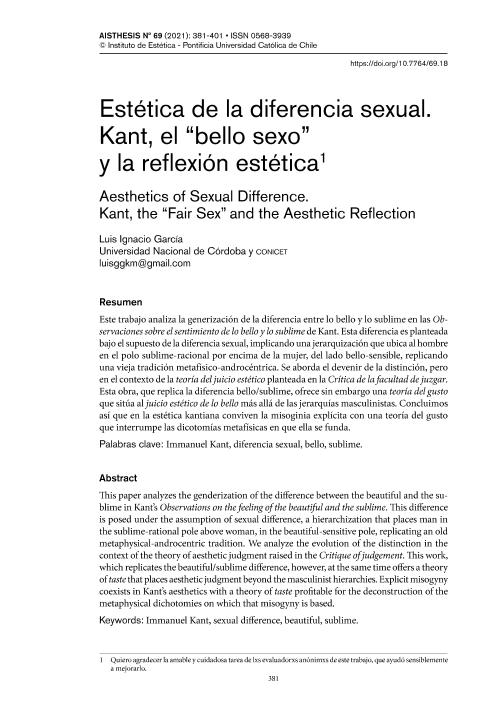Mostrar el registro sencillo del ítem
dc.contributor.author
Garcia Garcia, Luis Ignacio

dc.date.available
2022-10-31T17:39:32Z
dc.date.issued
2021-08
dc.identifier.citation
Garcia Garcia, Luis Ignacio; Estética de la diferencia sexual: Kant, el “bello sexo” y la reflexión estética; Pontificia Universidad Católica de Chile. Instituto de Estética; Aisthesis; 69; 8-2021; 381-401
dc.identifier.issn
0568-3939
dc.identifier.uri
http://hdl.handle.net/11336/175654
dc.description.abstract
Este trabajo analiza la generización de la diferencia entre lo bello y lo sublime en las Observaciones sobre el sentimiento de lo bello y lo sublime de Kant. Esta diferencia es planteada bajo el supuesto de la diferencia sexual, implicando una jerarquización que ubica al hombre en el polo sublime-racional por encima de la mujer, del lado bello-sensible, replicandouna vieja tradición metafísico-androcéntrica. Se aborda el devenir de la distinción, peroen el contexto de la teoría del juicio estético planteada en la Crítica de la facultad de juzgar.Esta obra, que replica la diferencia bello/sublime, ofrece sin embargo una teoría del gusto que sitúa al juicio estético de lo bello más allá de las jerarquías masculinistas. Concluimos así que en la estética kantiana conviven la misoginia explícita con una teoría del gusto que interrumpe las dicotomías metafísicas en que ella se funda.
dc.description.abstract
This paper analyzes the genderization of the difference between the beautiful and the sublime in Kant’s Observations on the feeling of the beautiful and the sublime. This difference is posed under the assumption of sexual difference, a hierarchization that places man in the sublime-rational pole above woman, in the beautiful-sensitive pole, replicating an old metaphysical-androcentric tradition. We analyze the evolution of the distinction in the context of the theory of aesthetic judgment raised in the Critique of judgement. This work, which replicates the beautiful/sublime difference, however, at the same time offers a theory of taste that places aesthetic judgment beyond the masculinist hierarchies. Explicit misogyny coexists in Kant’s aesthetics with a theory of taste profitable for the deconstruction of the metaphysical dichotomies on which that misogyny is based.
dc.format
application/pdf
dc.language.iso
spa
dc.publisher
Pontificia Universidad Católica de Chile. Instituto de Estética
dc.rights
info:eu-repo/semantics/openAccess
dc.rights.uri
https://creativecommons.org/licenses/by-nc-sa/2.5/ar/
dc.subject
IMMANUEL KANT
dc.subject
DIFERENCIA SEXUAL
dc.subject
BELLO
dc.subject
SUBLIME
dc.subject.classification
Filosofía, Historia y Filosofía de la Ciencia y la Tecnología

dc.subject.classification
Filosofía, Ética y Religión

dc.subject.classification
HUMANIDADES

dc.subject.classification
Otras Artes

dc.subject.classification
Arte

dc.subject.classification
HUMANIDADES

dc.subject.classification
Ciencias Sociales Interdisciplinarias

dc.subject.classification
Otras Ciencias Sociales

dc.subject.classification
CIENCIAS SOCIALES

dc.title
Estética de la diferencia sexual: Kant, el “bello sexo” y la reflexión estética
dc.title
Aesthetics of Sexual Difference: Kant, the “Fair Sex” and the Aesthetic Reflection
dc.type
info:eu-repo/semantics/article
dc.type
info:ar-repo/semantics/artículo
dc.type
info:eu-repo/semantics/publishedVersion
dc.date.updated
2022-09-12T18:38:36Z
dc.identifier.eissn
0718-7181
dc.journal.number
69
dc.journal.pagination
381-401
dc.journal.pais
Chile

dc.journal.ciudad
Santiago de Chile
dc.description.fil
Fil: Garcia Garcia, Luis Ignacio. Consejo Nacional de Investigaciones Científicas y Técnicas. Centro Científico Tecnológico Conicet - Córdoba. Instituto de Humanidades. Universidad Nacional de Córdoba. Instituto de Humanidades; Argentina
dc.journal.title
Aisthesis
dc.relation.alternativeid
info:eu-repo/semantics/altIdentifier/url/http://revistaaisthesis.uc.cl/index.php/RAIT/article/view/30957
dc.relation.alternativeid
info:eu-repo/semantics/altIdentifier/doi/http://dx.doi.org/10.7764/69.18
Archivos asociados
